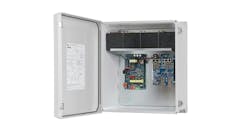Locksmiths looking to grow their businesses in a challenging economy might want to consider installing alarm systems. After all, security starts at home, and locksmiths have been securing premises, both commercial and residential, for decades (perhaps centuries) before electronic alarm systems existed.
It’s a natural progression for an alarm installer to point out to a client the value of good locks, or for a locksmith to point out the benefits of having an alarm system to every client with whom he comes into contact.
Alarm systems have been proven to be both a necessity for many people, and that a professionally installed alarm system deters crime.
Private security in the United States began in 1851, when Alan Pinkerton founded what would become the Pinkerton Detective Agency. By 2006 private security had grown to become a $150 billion per year industry.
The market for alarm systems, sold by the private security industry, is about $30 billion annually, growing at a compound annual rate of 7 to 8 percent.
A recent AIREF Study reports that burglar alarms had a positive impact on the immediate neighborhood by decreasing residential burglaries and that a burglar alarm, as a target hardening measure of situational crime prevention, not only protects the home without displacing burglary to nearby houses, but, in fact, also provides these other houses with protection from burglars
Some 2007 FBI Crime Statistics:
- In 2007, 17.5 million property crimes took place.
- A burglary occurs every 14 seconds in the United States
- The vast majority of burglaries take place during the day, between 6 a.m. and 6 p.m.
- The average victim of a burglary lost property worth around $2,000.
- The burglar enters through the main entrance to the house, normally the front door, in more than a third of burglaries.
- Historically speaking, when the economy is not doing well, property crime and burglary have increased.
- Homes with monitored security systems are three times less likely to be broken into or robbed than homes without such a system.
Why Wireless?
The trends in alarm systems include wireless, home automation and enhanced reporting and control capabilities. Unlike previous times, home owners are less likely to have land lines. Advantages of wireless alarms include:
Size: New manufacturing techniques have permitted the miniaturization of wireless transmitters and receivers dramatically. Technology has also reduced power requirements to incredibly low levels.
Battery life: Modern wireless provides extended operation and battery life.
Range: Modern wireless equipment use frequency spectrums which go further on less power. Frequencies are less vulnerable to physical and atmospheric issues. The technology relies less on line of sight.
Reliability: Besides more favorable frequency spectrums, wireless security technologies are supervised. This means that if the signal path is blocked, the system will know and can notify someone. Supervision also can provide for two-way handshaking between transmitters and receivers. Handshaking and supervision is common to hard-wired security technologies, but not ubiquitous to all wireless technologies. The introduction of supervision cleared the way for wireless in electronic security and has resulted in wireless essentially taking over the industry.
Security: Along with supervision, encryption is used to prevent signals to be intercepted, for erroneous signals to create false alarms or for other disruption of data to occur.
User Acceptance: These days, customers are demanding wireless. Demand for wireless is an important market driver, and since everyone sells it, offering wireless is not a differentiator unless you don’t offer it, in which case you lose.
New Company, New Technology
2GIG Technologies manufacturers a self-contained alarm panel with features that prevent it from being defeated. Its technology supports automation features including access control. Additionally the user interface is non-intimidating, encouraging end-users to actually use the product while helping to mitigate user error based false alarms.
2GIG Technologies’ GO!Control is a self-contained security and home automation system. Features include color touch screen, GSM radio and Z-Wave chip. The color touch screen enables easy and luxurious user interface. The |GSM radio enables installations to be monitored without a land-line, and enable the panel firmware to be updated, new powerful feature-rich apps to be downloaded, and enhanced integration features to be deployed.
The Go!Control Security System represents a signi?cant advancement in fully supervised wireless security systems. The security system control panel incorporates many advanced and sophisticated features. The system can be expanded and customized to ?t the installation’s speci?c needs.
Designed to meet or exceed the requirements for ETL Listed residential security installations, the system also conforms to the Security Industry Association’s Control Panel Standard ANSI/SIA CP-01-2007. For an ETL smoke alarm system, there must be at least one smoke detector programmed into the Control Panel to meet National Fire Protection Association (NFPA) Rule 72-Chapter 2, and UL 217 requirements.
The system’s Control Panel features a color touch screen display that allows control of all system functions and programming. The display clearly shows the installer and subscriber system and installation status. The helpful scrolling text, along with the voice prompts that the Control Panel sounds, make installation, programming, and operation easy compared to keypad-programmed and operated security systems of the past.
The system supports 48 wireless sensors of various types, two hardwire loops, 15 sensor response types, a supervised bell output, and a programmable (open collector) solid-state control output.
An on-board digital communicator reports alarms and trouble to a central monitoring station receiver via the standard telephone network. The Control Panel also supports two-way voice communications with the Central Station.
An internal narrow-band radio receiver detects signals from wireless system sensors. The high-gain receiver allows for easy placement of the wireless sensors so signals can be received in even the toughest of installation environments.
For enhanced operation, an optional Model 2GIG-GSMx global system for mobile communications module (GSM radio modem) can be initially installed or retrofitted in the ?eld.
With the optional GSM radio modem installed, the system will have wireless Central Station reporting capability. Two-way voice communication with the Central Station can also go “over-the-air” through the GSM radio modem.
The optional GSM radio modem also allows 2-way communications with the Alarm.com server. Through Alarm.com, subscribers can query and control their system using a computer browser from anywhere in the world.
The Alarm.com server can also send messages, time corrections, and software updates to the Control Panel. Special messages from the server are displayed to the subscriber on the Control Panel’s color touch screen.
For home control, the Control Panel’s built-in Z-Wave radio module allows controlling and monitoring various home automation devices such as lighting, heating, and air conditioning. Currently, the 2GIG supports specific Kwikset wireless locks.
According to 2GIG’s CEO Lance Dean, new features, apps and supported partner devices are in the pipeline .
Eight user codes including a duress code are supported. User “one” is the master code that can add or delete the other seven user codes. The Installer Code has access to system programming.
The 2GIG has been out for about a year and is reportedly the fastest growing security system. It is also easy and fast to deploy. The majority of installs are performed in an hour, and are deployed using GSM only (no phone line) reducing wiring and also rendering the system with a unique immunity to compromise.
Features & Controls
Keypad features and controls include:
Alarm Sounder And Speaker: Sounds all system local alarms, voice prompts, system sounds, and audio for 2-way voice communications with the Central Station
Emergency Button / Indicator: Flashes WHITE during emergency alarm
Color Display With Touch Screen: Shows all system information, status, programming, and functions as the keypad. Displays cycles clock, calendar, and weather (press to manually change)
Microphone: For voice communication with the Central Station
Home Button / Indicator
- Indicator flashes during power outages (system on battery backup)
- Flashes GREEN when ALL sensors are closed (ready to arm)
- Flashes ORANGE when ANY sensor is open (not ready to arm)
- Flashes RED while system is armed
Wireless Accessories
2GIG-DW10 Thin Door/Window Contact
- For narrow applications sensor is only 3/4” wide
- Fully supervised
- Rare earth magnet
- Lithium battery
- Supports internal and external contacts
- Can be used for two zones of protection
- 345 MHz
- ETL Listed
2GIG-DW20R Recessed Door Contact
- Compact size, only 2-1/2” long
- Fully supervised
- Rare earth magnet
- Lithium battery
- 345 MHz
- ETL Listed
2GIG-PIR1 Passive Infrared Motion Detector
- Dual element sensor with 50’ by 50’ range
- 45 lb. pet immune
- 90 degree look down
- Lithium battery
- 345 MHz
- ETL Listed
2GIG-KEY1 4-Button Key Ring Remote
- Arms system in Stay or Away Mode
- Disarms system
- Auxiliary output and emergency functions
- Lithium battery
- 345 MHz
2GIG-PANIC1 Panic Button Remote
- For triggering emergency alarm
- Small and lightweight
- 5-second button lockout
- Lithium battery
- 345 MHz
- ETL Listed
2GIG-GB1 Glass Break Detector
- Monitors for the sound of breaking glass
- Two test LEDs
- Dual shatter recognition technology (thud then crash)
- Lithium battery
- 345 MHz
- ETL Listed
2GIG-SMKT2 Smoke and Heat Detector
- Photoelectric-type detector with rate-of-rise and ?xed 135° heat sensors
- Status indicator
- Built-in 85 dBA sounder
- Lithium battery
- 345 MHz
- ETL Listed
2GIG-PAD1 Wireless Keypad
- Arms system in Stay or Away Mode
- Disarms system
- Fire and Panic emergency functions
- Lithium batteries
- 345 MHz
- ETL Listed
2GIG-TAKE-345 Super Switch Wireless Takeover Module
- Eight-channel transmitter
- Converts up to eight hardwired loops into eight wireless sensor zones
- 9-16 VDC, 50 mA
- Can be powered from existing Control Panel
- 345 MHz
- ETL Listed
2GIG-GSMx GSM Module
- Cellular telephone module
- Plugs into Control Panel
- Provides 2-way GSM radio communication
- Enrolls with cellular service provider
2GIG-BATT1 Standard Battery Pack
- Standard battery suppliedwith Control Panel
- Also available as a replacement Item
- Nickel metal hydride (NiMH) battery
For more information, visit www.2gig.com.
Tim O'Leary
Tim O'Leary is a security consultant, trainer and technician who has also been writing articles on all areas of locksmithing & physical security for many years.






